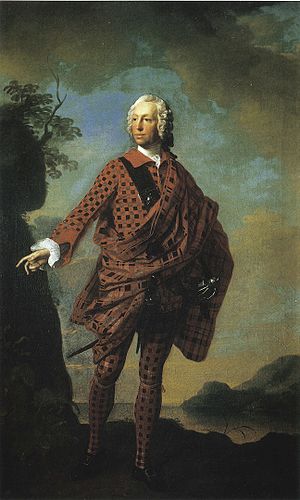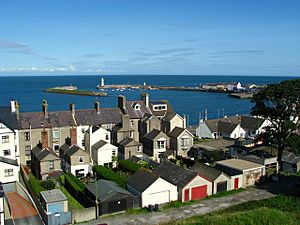Ship of the People facts for kids
The "Ship of the People" was a sad event that happened in 1740 in Scotland. It was a plan by two powerful clan leaders, Norman MacLeod and Sir Alexander MacDonald, to trick and kidnap many people from their homes. These people were then forced onto a ship called the William, meant to take them far away to America to work without pay.
However, the plan went wrong when the ship stopped in Ireland. Some of the kidnapped people tried to escape, which caught the attention of local police. The clan leaders managed to avoid getting into trouble, but the people who were taken were set free. Most of them stayed in Ireland and did not return to their homes in Scotland.
Contents
Why the Plan Started

Norman MacLeod was the leader of Clan MacLeod. He lived a very fancy life and spent a lot of money. Because of this, he got into a lot of debt, meaning he owed a lot of money to many people. This debt was so big it threatened to make him lose everything he owned.
At that time in Scotland, it was sometimes known for powerful people to trick or force their own tenants (people who lived on their land) into working for them for many years, often in faraway lands. This was called indentured servitude. It was like being forced to work for a long time without getting paid, and it was a very unfair practice.
Norman MacLeod, along with another clan leader, Sir Alexander MacDonald, came up with the plan to kidnap many of their own tenants. They pretended these people were criminals, even though they were not. To help them, they hired a manager named Norman MacLeod of Unish and a ship captain named William Davidson.
The Kidnapping Journey
On August 13, 1740, the ship William left a place called Donaghadee in what is now Northern Ireland. The captain said they were going to Norway, but that was a lie. A few days later, the ship secretly arrived at the Isle of Skye in Scotland.
On the island, nearly 100 men, women, and even young children (some as young as five years old) were taken from their homes by force. Most of these people lived on Norman MacLeod's land, but some were from Sir Alexander MacDonald's land too. After leaving Skye, the William went to the Isle of Harris to kidnap even more people.
The ship then made a quick stop to let off people who looked too weak to survive a long trip across the ocean. Finally, on October 20, the ship stopped again in Donaghadee to get supplies for the long journey to America. If the ship had reached America, these kidnapped people would have been forced to work in very harsh conditions, almost like slavery.
Escape and Discovery
While the ship was in Ireland, some of the kidnapped people tried to escape. They ran towards a nearby town called Bangor. However, Captain Davidson and Norman MacLeod of Unish caught them and beat them badly.
But this escape attempt made the local police curious. They found the kidnapped people being held in barns owned by Captain Davidson. When the police tried to arrest the two men in charge, they managed to escape and disappeared. News of this terrible event reached the government in Dublin and then spread to Scotland, causing a big scandal.
What Happened Next
Both Norman MacLeod and Sir Alexander MacDonald said they had nothing to do with the kidnapping. They claimed they were only sending away criminals who were already on the island, and that no innocent people were on the ship. However, the victims and even Norman MacLeod of Unish said that Norman MacLeod (the clan chief) was the main person who planned everything.
Norman MacLeod asked for help from a powerful judge named Duncan Forbes. He told Forbes he was innocent and that it would be very hard to prove he was guilty. Judge Forbes was known for avoiding difficult legal cases, so he did not charge either clan chief for their part in the kidnapping. He even helped Norman MacLeod hide his involvement in the incident.
Arrest warrants were issued for Norman MacLeod of Unish and Captain Davidson, but they both disappeared after the scandal. Norman MacLeod of Unish later settled in the Netherlands. The people who had been kidnapped were finally set free. Most of them stayed in and around Donaghadee in Ireland, and only a few went back to their homes in Scotland.
The Impact of the Event
The "Ship of the People" scandal almost ruined the special relationship between the MacLeod clan and their chiefs. This event, along with other bad things Norman MacLeod did, earned him the nickname "The Wicked Man." This name stuck with him for a very long time, even though later chiefs tried to make his image better.
A poet named Sorley MacLean said that this event was an early example of the Highland Clearances. The Highland Clearances were a time in the 1800s when thousands of people were forced off their lands by powerful landlords.
During a big rebellion in 1745, Norman MacLeod chose to support the British government instead of the rebels, even though his clan usually supported the rebels. Some historians believe he did this because he was afraid of what Judge Forbes might do to him if he didn't support the government, especially after the kidnapping scandal.
See also


